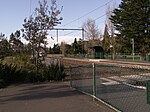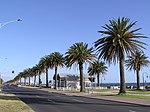North Port light rail station
1987 disestablishments in AustraliaBuildings and structures in the City of Port PhillipDisused railway stations in MelbourneMelbourne rail transport stubsRailway stations closed in 1987 ... and 4 more
Railway stations in Australia opened in 1859Tram stubsUse Australian English from February 2015Victoria (state) railway station stubs
North Port is a light rail station and a former railway station on Port Melbourne railway line, first significant railway in Melbourne, Australia. The station is located in the inner Melbourne suburb of Port Melbourne, Victoria, Australia. Though it was closed in 1987 for conversion to light rail, Melbourne tram route 109 now runs through the station with newly built low-floor platforms. The station was located to the south of Raglan Street and between Evans Street and Station Street.
Excerpt from the Wikipedia article North Port light rail station (License: CC BY-SA 3.0, Authors).North Port light rail station
Sandridge Rail Trail, Melbourne Port Melbourne
Geographical coordinates (GPS) Address Nearby Places Show on map
Geographical coordinates (GPS)
| Latitude | Longitude |
|---|---|
| N -37.833333333333 ° | E 144.94333333333 ° |
Address
Stop 127: North Port
Sandridge Rail Trail
3207 Melbourne, Port Melbourne
Victoria, Australia
Open on Google Maps









